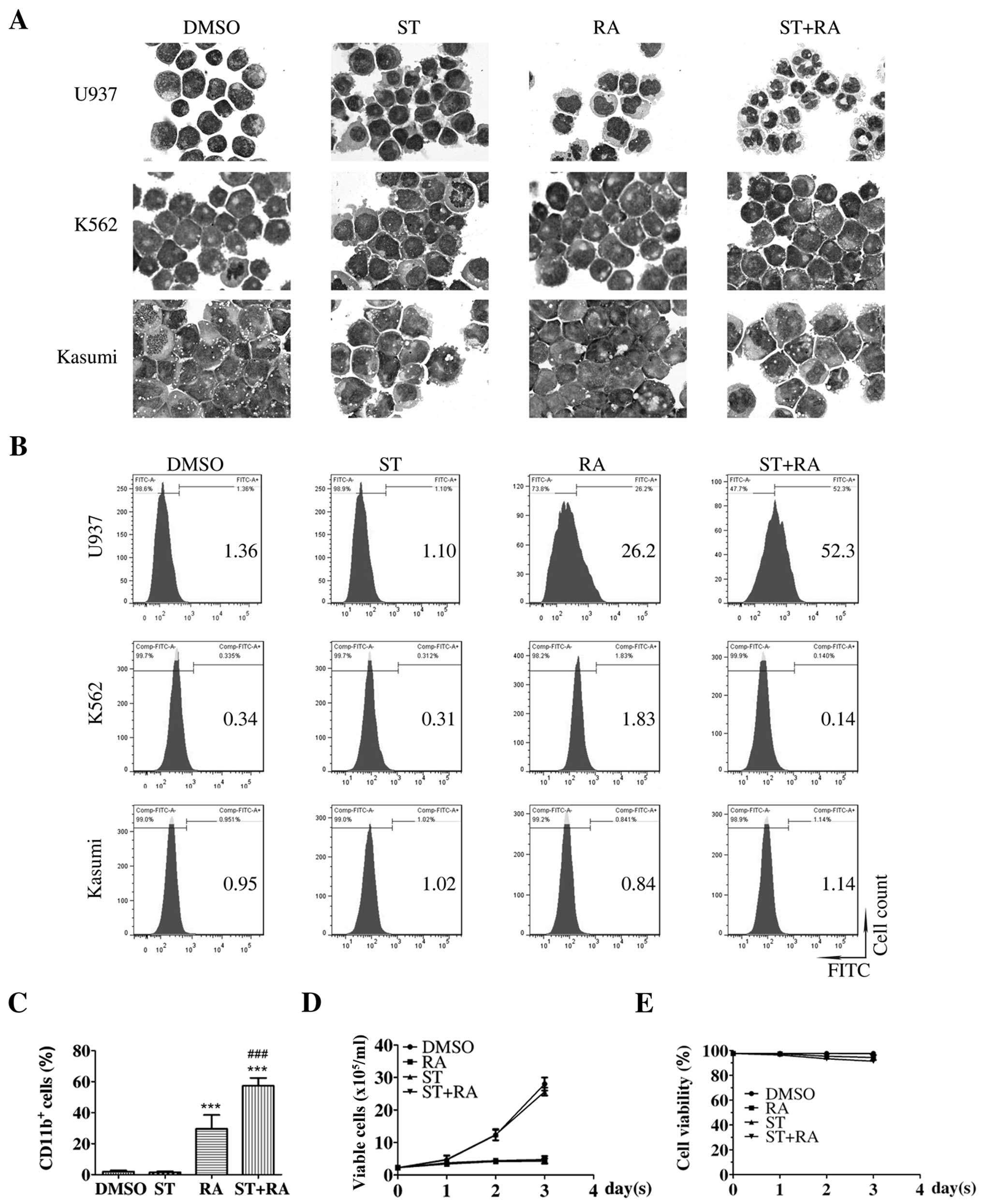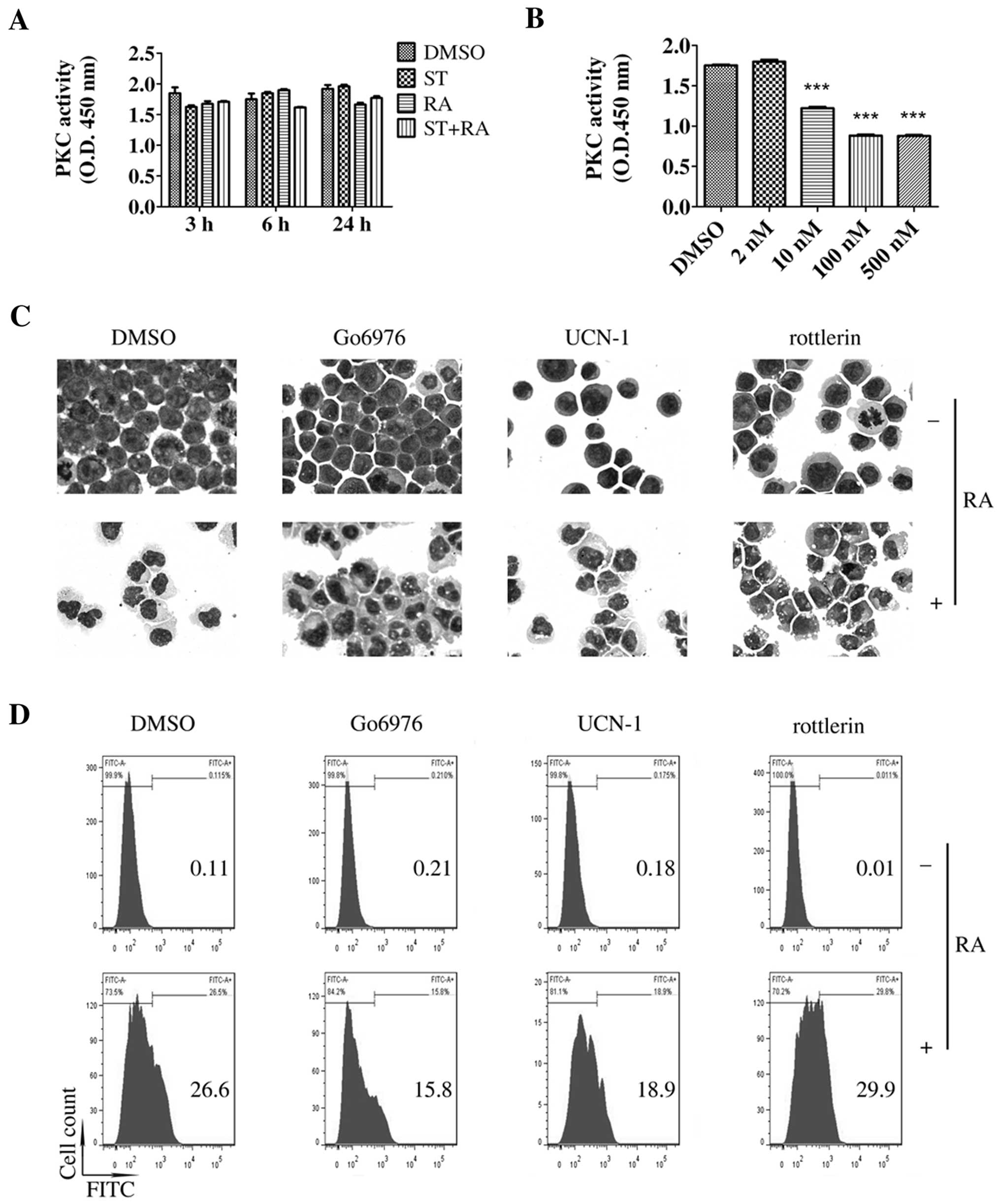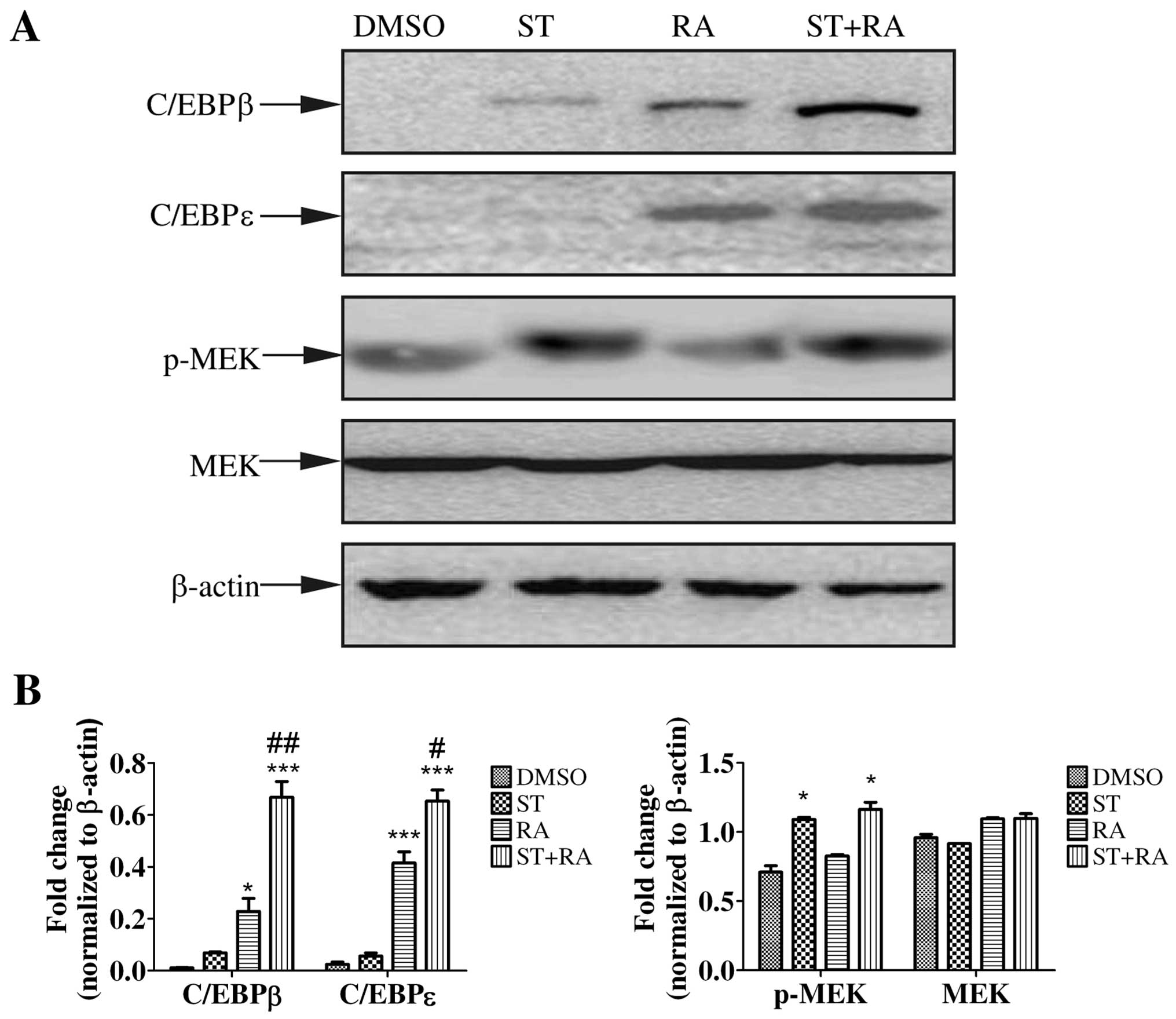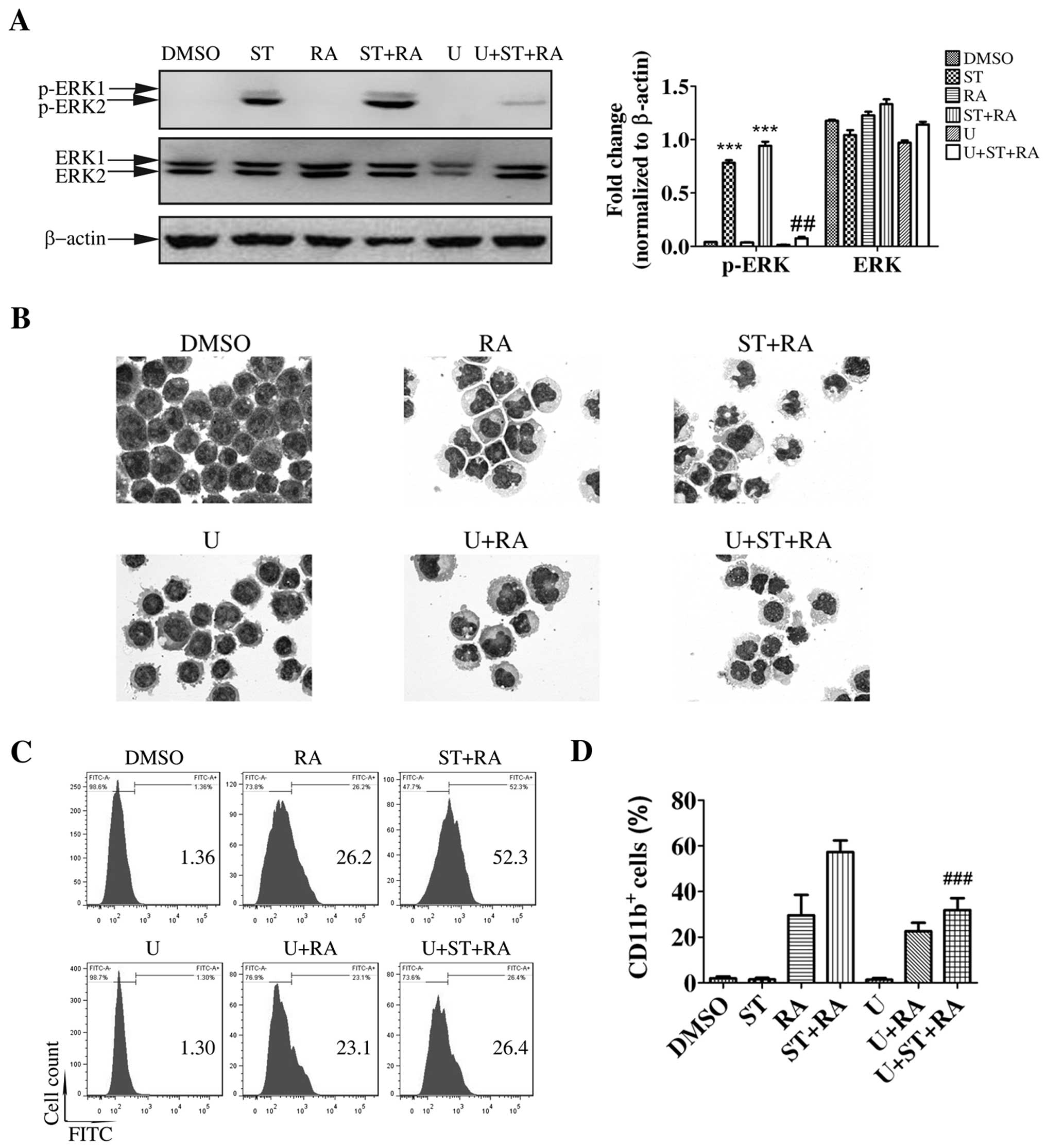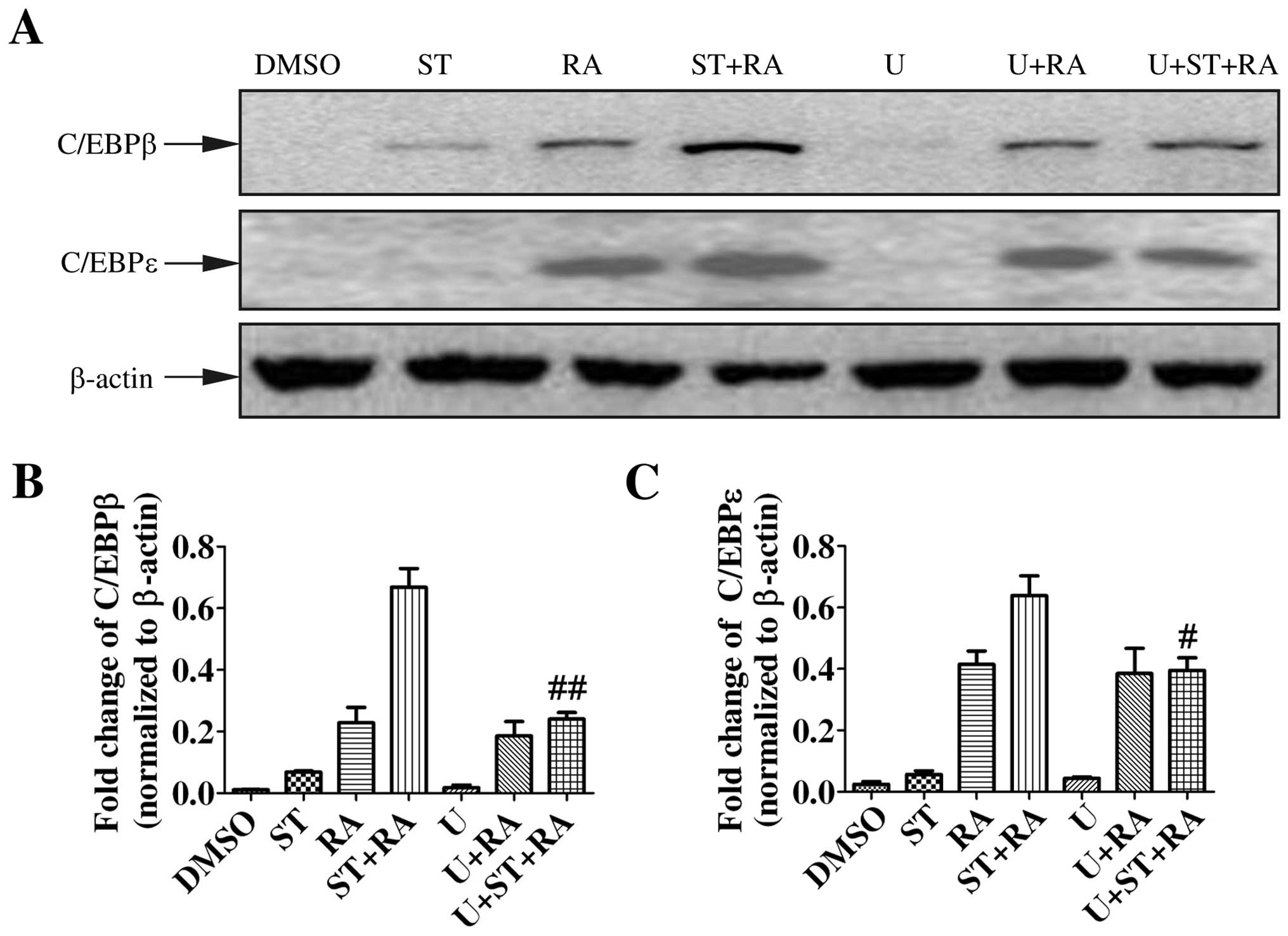Staurosporine enhances ATRA-induced granulocytic differentiation in human leukemia U937 cells via the MEK/ERK signaling pathway
- Authors:
- Published online on: September 23, 2016 https://doi.org/10.3892/or.2016.5123
- Pages: 3072-3080
Abstract
Introduction
Acute myeloid leukemia (AML) accounts for approximately 80% of acute leukemia cases with a median age of 67 years (1). Its incidence is expected to increase with the improvement in life expectancy. In AML patients younger than 60 years, the clinical management is based on high-dose chemotherapy. However, in the majority of AML patients older than 60 years, such chemotherapy is associated with high mortality. Thus, the development of novel and effective anti-AML therapies is urgently required.
Differentiation therapy, which is associated with relatively less severe side effects, may be an alternative to chemotherapy in this circumstance. All-trans retinoic acid (ATRA), a prominent example of differentiation therapy, has been successfully applied in the treatment of acute promyelocytic leukemia (APL) for decades (2). The degradation of promyelocytic leukemia (PML)-retinoic acid receptor (RAR) α fusion protein, the key player in APL leukemogenesis, is widely accepted as one of the important mechanisms of ATRA treatment in APL patients (2). Unfortunately, ATRA-induced differentiation of AML cells has only been observed in APL patients. Since the RA signaling pathway is involved in the regulation of myeloid differentiation and all other AML subtypes express RARs, research approaches that further sensitize cells to ATRA and extend the efficacy of ATRA-based therapy to non-APL AML are being sought. Molecules involved in the epigenetic modulation of the RA signaling pathway have become therapeutic targets of AML. For example, valproic acid (VPA), an inhibitor of histone deacetylase, was found to exhibit a synergistic differentiation-inducing effect with ATRA in an AML cell line and primary AML cells (3). However, clinical trials of VPA combined with ATRA in AML patients did not demonstrate improvement in complete remission (4–6). Inhibition of lysine-specific demethylase 1 by tranylcypromine was shown to unlock the ATRA-triggered differentiation in non-APL AML, suggesting that such epigenetic therapy with ATRA may yield clinical benefit in AML (7). Other approaches which prevented the degradation of RARα were also demonstrated to increase sensitivity to ATRA in ATRA-responsive cell lines, HL-60 and NB4 (8,9).
Staurosporine is a highly potent but non-specific inhibitor of protein kinase C (PKC), which has demonstrated antitumor activity in a variety of cell lines by inducing apoptosis or differentiation (10–14). Staurosporine was found to synergize with ATRA to trigger granulocytic differentiation in the ATRA-sensitive HL-60 cell line, an AML-M2 cell line with morphology similar to APL cells but without the APL symbol, PML-RARα fusion protein (15). Moreover, such synergism was also observed in ATRA-resistant APL cell lines (16). Since the differentiation induced by the combined treatment was independent of the PML-RARα fusion protein in ATRA-resistant APL cell lines (16) and such a combination was also effective in one non-APL AML cell line HL-60, we were encouraged to investigate the effect of the combined treatment on other AML cell lines. The AML-M2b cell line Kasumi, erythroleukemia cell line K562 and monocytic leukemia cell line U937 were studied. Staurosporine could not restore ATRA sensitivity in ATRA unresponsive cell lines, K562 and Kasumi. However, it significantly enhanced ATRA-induced granulocytic differentiation and upregulation of CCAAT/enhancer-binding protein β (C/EBPβ) and C/EBPε in U937 cells. Both enhanced effects of staurosporine were dependent on mitogen-activated protein kinase kinase (MEK)/extracellular signal-regulated kinase (ERK) activation.
Materials and methods
Reagents
ATRA was purchased from Sigma-Aldrich (St. Louis, MO, USA). UCN-1, Go6976, rottlerin, staurosporine and U0126 were obtained from EMD Chemicals, Inc. (San Diego, CA, USA). They were all dissolved in dimethyl sulfoxide (DMSO) as a stock solution at 1 mM, 100 µM, 100 µM, 2 mM, 2 µM and 10 mM, respectively.
Cell culture, cell viability and cell proliferation
U937, K562 and Kasumi cell lines were cultured in RPMI-1640 medium, supplemented with 10% fetal calf serum (Thermo Fisher Scientific Inc., Waltham, MA, USA) in a humidified atmosphere of 95% air/5% CO2 at 37°C. To avoid possible effects of cell density on cell growth and survival, the cells were maintained at less than 5×105 cells/ml. Cell viability was assessed by trypan-blue exclusion assay. Actual viable cell numbers were calculated by multiplying diluted times with the counted viable cell numbers.
Cell differentiation assays
Cell maturation was evaluated by cellular morphology and the content of cell surface differentiation-related antigen CD11b. Morphology was determined using May-Grünwald-Giemsa staining of cells centrifuged onto slides by cytospin (500 rpm, 5 min; Shandon, Runcorn, UK) and viewed at ×1,000 magnification. The expression of cell surface differentiation-related antigen CD11b was determined by flow cytometry (EPICS XL; Beckman Coulter, Hialeah, FL, USA). Fluorochrome-labeled anti-human CD11b/FITC antibodies were purchased from Immunotech (Marseilles, France).
PKC activity assay by ELISA
Detection of PKC activity was performed by ELISA using PKC kinase activity kit (Enzo Life Sciences, Inc., Farmingdale, NY, USA) according to the manufacturer's instructions. Briefly, the cells were lysed with lysis buffer (20 mM MOPS, 1% NP-40, 5 mM EGTA, 2 mM EDTA, 1 mM DTT) and cell lysates were centrifuged at 13,000 rpm for 20 min at 4°C. Supernatants were collected and quantified by Bio-Rad DC protein assay (Bio-Rad Laboratories, Hercules, CA, USA). Five micrograms of protein extracts together with 10 µg ATP were added to PKC substrate microtiter plate and incubated at 30°C for 90 min. After washing four times, samples were incubated with phospho-specific substrate antibody followed by horseradish peroxidase (HRP)-conjugated anti-rabbit IgG. Protein binding was quantified by adding TMB substrate and measuring absorbance at 450 nm in a microplate reader (BioTek Instruments, Inc., Winooski, VT, USA).
Western blot analysis
Cells were washed with phosphate-buffered saline (PBS) twice and lysed with RIPA buffer (Sigma-Aldrich). Cell lysates were centrifuged at 13,000 rpm for 10 min at 4°C. Supernatants were collected and quantified by Bio-Rad DC protein assay. Protein extracts were loaded on 8% SDS-polyacrylamide gel, subjected to electrophoresis, and transferred to polyvinylidene difluoride membranes (GE Healthcare UK Ltd., Buckinghamshire, UK). After blocking with 5% nonfat milk in PBS, the membranes were probed with antibodies against C/EBPε, C/EBPβ, anti-β-actin (all from Santa Cruz Biotechnology, Inc., Dallas, TX, USA), phospho-MEK1/2 (Ser217/Try 221) and phospho-p44/42 Erk1/2 (Thr202/Try 204) (Cell Signaling Technology, Inc., Beverly, MA, USA). Then, the membranes were incubated with HRP-conjugated secondary antibody (GE Healthcare UK Ltd.). Immunocomplexes were visualized by a chemiluminescence kit (GE Healthcare UK Ltd.) according to the manufacturer's instructions. To detect Erk1/2 and MEK1/2, the same membrane incubated with the phosphorylated MEK1/2 or Erk1/2 was stripped with stripping buffer (2% SDS, 100 mM β-mercaptoethanol, 50 mM Tris, pH 6.8) followed by blocking and probing with anti-MEK1/2 or anti-Erk1/2 (both from Cell Signaling Technology, Inc.). The density of the protein band was quantitated using ImageJ software (National Institutes of Health, Bethesda, MD, USA) and expressed as the mean ± standard deviation (SD) of the relative levels of the objective protein and β-actin from three independent experiments.
Statistical analysis
For the PKC kinase assay and quantitated analysis of the proteins, a two-tailed unpaired Student's t-test was used. The flow cytometric analysis of CD11b was analyzed by Chi-square test (χ2).
Results
Staurosporine enhances ATRA-induced granulocytic differentiation in U937 cells
To investigate the effect of the combined treatment of staurosporine and ATRA on K562, Kasumi and U937 cells, we first tested the concentration of staurosporine studied in these cell lines. Five nanomoles of staurosporine was used to treat the K562 cells while 2 nM was applied to treat the Kasumi and U937 cells since they were the maximum concentrations with no obvious effects on cell proliferation and survival in these cell lines for 72 h (data not shown). The corresponding DMSO concentrations were regarded as solvent controls since both ATRA and staurosporine were dissolved in it.
The cells were treated with 1 µM ATRA and the corresponding concentration of staurosporine for 72 h. Parental U937 cells presented irregular nuclei and a high nuclear/cytoplasm ratio, which was almost retained in the cells treated with 2 nM staurosporine (Fig. 1A, upper panel). After 1 µM ATRA treatment for 72 h, cells with decreased nuclear/cytoplasm ratio and kidney-shaped nuclei were observed. Following the combined treatment of 2 nM staurosporine and 1 µM ATRA for 72 h, cells displayed the appearance of matured granulocytes, such as lobed nuclei accompanied by markedly decreased nuclear/cytoplasm ratio (Fig. 1A, upper panel). However, no significant morphological change was presented in the K562 or Kasumi cells with either ATRA treatment or the combined treatment for 72 h (Fig. 1A, middle and lower panels). There was also no marked alteration in the population of CD11b+ cells in these two cell lines following these treatments (Fig. 1B, middle and lower panels). As shown in Fig. 1B and C, consistent with the morphological change, the percentage of CD11b+ cells was enhanced following ATRA treatment in the U937 cells (RA compared with DMSO, 29.6±3.2 vs. 2.0±0.5%, χ2=2877.1, P<0.001). Although staurosporine treatment alone did not elevate the percentage of CD11b+ U937 cells, following the combination of staurosporine and ATRA, a more than additive effect was observed. The percentage of CD11b+ U937 cells was significantly increased following the combined treatment (ST+RA compared with DMSO, 57.3±2.9 vs. 2.0±0.5%, χ2=7347.3, P<0.001; ST+RA compared with RA, 57.3±2.9 vs. 29.6±3.2%, χ2=1561.4, P<0.001; Fig. 1B and C). However, the percentage of CD14+ U937 cells was not altered with either ATRA or the combined treatment (data not shown). Thus, it was demonstrated that staurosporine enhanced ATRA-induced granulocytic differentiation in the U937 cells but not in the ATRA-unresponsive K562 and Kasumi cells. Meanwhile, staurosporine neither suppressed cell proliferation nor affected ATRA-inhibited cell growth in the U937 cells (Fig. 1D). The cell viability was maintained above 90% with any treatment for 72 h (Fig. 1E).
Staurosporine-enhanced ATRA-induced granulocytic differentiation in U937 cells is independent of PKC
To explore the mechanisms of the enhanced effect of staurosporine on ATRA-induced differentiation in U937 cells, we first examined the role of PKC since staurosporine is a potent PKC inhibitor with IC50 value of 2.7 nM in an isolated enzyme assay (10), a slightly higher concentration than we used in this study. As shown in Fig. 2A, compared with the PKC activity noted in the DMSO-treated cells, a similar level of PKC activity was detected following treatment with 2 nM staurosporine or the combined treatment. Staurosporine did inhibit PKC activity in the U937 cells only at concentrations of 10 nM or higher after a 6-h incubation (Fig. 2B). However, as mentioned above, 2 nM was the maximum concentration of staurosporine that could be applied in this study. Therefore, 2 nM staurosporine or the combined treatment had no effect on PKC activity.
U937 cells express PKC-βI, -βII, -δ, -ε and -ζ isoforms (17). To further confirm the role of PKC, we evaluated whether the combination of ATRA with several selective PKC inhibitors could mimic the effect of staurosporine on ATRA-induced differentiation in U937 cells. Go6976 (an inhibitor of PKC-α, -βI and -µ isoforms), UCN-01 (an inhibitor of PKC-α, -β, -γ, -δ, and -ε isoforms) and rottlerin (an inhibitor of PKC-δ, -α, -β, -γ, -ε and -ζ isoforms) were used in the following experiment. Compared with ATRA treatment alone, no more matured cells were observed following the combined treatment of ATRA and any of the above selective PKC inhibitors (Fig. 2C). CD11b+ cells were slightly increased by the combined treatment of rottlerin and ATRA while Go6976 or UCN-01 decreased the ATRA-enhanced population of CD11b+ cells (Fig. 2D). Thus, these selective PKC inhibitors did not enhance ATRA-induced differentiation in the U937 cells. Therefore, it was suggested that staurosporine-enhanced ATRA-induced granulocytic differentiation in U937 cells may be independent of PKC.
Staurosporine activates MEK/ERK and enhances ATRA-promoted upregulation of C/EBPs
To further investigate the molecular mechanisms of the enhanced effect of staurosporine on ATRA-induced differentiation in U937 cells, we focused on certain proteins or signaling pathways involving in granulocytic differentiation. First, we examined the protein level of C/EBPβ and C/EBPε by immunoblotting. The induction of C/EBPβ and C/EBPε expression is implicated in the later stage of granulocytic differentiation (18,19). Moreover, C/EBPβ and C/EBPε were demonstrated to be required for ATRA-mediated differentiation in APL cells (20,21). Therefore, U937 cells were treated with 2 nM staurosporine, 1 µM ATRA, or the combined treatment for 24 h. As shown in Fig. 3, ATRA enhanced the protein levels of both C/EBPβ and C/EBPε while staurosporine only slightly elevated the C/EBPβ protein level but not C/EBPε. However, with the addition of staurosporine to ATRA treatment, the upregulation of C/EBPβ and C/EBPε was more marked (Fig. 3).
Activation of MEK/ERK was demonstrated to be required for some cytokine-induced myeloid differentiation as well as ATRA-triggered granulocytic differentiation in APL cells (22–26). To explore whether the MEK/ERK signaling pathway was activated, phosphorylated MEK and ERK1/2 were assessed by western blot analysis in cells treated with 1 µM ATRA or/and 2 nM staurosporine for 24 h. As shown in Figs. 3 and 4A, staurosporine but not ATRA increased the amount of phosphorylation of MEK and ERK1/2. Similar levels of phosphorylated MEK and ERK1/2 were detected following the combined treatment. The total amount of MEK and ERK1/2 in both cell lines remained almost unaltered. Therefore, only staurosporine could activate the MEK/ERK signaling pathway.
MEK/ERK activation is required for the enhanced effect of staurosporine on ATRA-induced granulocytic differentiation and the upregulation of C/EBPs
Having validated the activation of MEK/ERK by staurosporine, we next ascertained whether the MEK/ERK signaling pathway was required for staurosporine-enhanced ATRA-induced granulocytic differentiation in U937 cells. Cells were treated with 10 µM U0126, a specific inhibitor of MEK for 1 h prior to the other treatments. The effectiveness of U0126 was assessed by ERK1/2 phosphorylation. U0126 did suppress ERK1/2 activation in the U937 cells following the combined treatment (Fig. 4A). Meanwhile, U0126 partially inhibited differentiation induced by the combination of staurosporine and ATRA. Following U0126 pretreatment, typical granulocytic differentiated cells with lobed nuclei observed following the combined treatment were displaced by cells with kidney-shaped or round nuclei, which were also presented following ATRA treatment (Fig. 4B). However, U0126 pretreatment barely affected the morphological change with ATRA treatment (Fig. 4B). In addition, following U0126 pretreatment, the increased percentage of CD11b+ cells following the combined treatment was significantly decreased to a similar level as that following ATRA treatment (U+ST+RA compared with ST+RA, 31.9±3.1 vs. 57.3±2.9%, χ2=1312.8, P<0.001; Fig. 4C and D). Whereas, U0126 only slightly suppressed the population of CD11b+ cells with ATRA treatment (Fig. 4C and D). These results excluded the effect of the MEK/ERK signaling pathway on ATRA-triggered differentiation but highlighted its major role in the enhanced effect of staurosporine on ATRA-induced granulocytic differentiation in U937 cells.
Consistent with cell differentiation, U0126 pretreatment attenuated the combined treatment-enhanced C/EBPβ and C/EBPε protein levels to a similar level of that following ATRA treatment. However, the increased protein levels of C/EBPβ and C/EBPε following ATRA treatment were not altered in the presence of U0126 (Fig. 5). Therefore, staurosporine-enhanced upregulation of C/EBPβ and C/EBPε following ATRA treatment was mediated by the MEK/ERK signaling pathway.
Discussion
In the present study, we first demonstrated that staurosporine enhanced ATRA-induced granulocytic differentiation in U937 cells. A high concentration of staurosporine (1 µM) was reported to induce necroptotic cell death while a relatively lower concentration (100 nM staurosporine) was found to activate rapid homotypic intercellular adhesion of U937 cells (27,28). To the best of our knowledge, this is the first study to show that very low concentrations of staurosporine exhibit synergism with ATRA to promote granulocytic differentiation in U937 cells. However, the combination of staurosporine and ATRA did not induce differentiation in ATRA-unresponsive cell lines K562 and Kasumi. It was also previously shown that the same combined treatment synergized to trigger differentiation in ATRA-resistant APL cell lines NB4-R1 and NB4-R2 (16). Although NB4-R1 and NB4-R2 cell lines were regarded as ATRA-resistant cell lines, they are not completely unresponsive to ATRA. They are just poorly sensitive to ATRA, that is, ATRA slightly increased the content of CD11b+ cells accompanied by some morphologically partial differentiation cells in these two cell lines (16). Meanwhile, 5 nM staurosporine also achieved the similar enhanced effect in ATRA-sensitive HL-60 cells (15). Therefore, it was suggested that staurosporine may only be able to enhance ATRA-promoted differentiation but not to restore ATRA sensitivity.
Staurosporine is a potent but non-selective PKC inhibitor. Some PKC isoforms regulate granulocytic differentiation, that is, PKC-α was suggested to negatively modulate terminal neutrophil differentiation while activated PKC-δ resulted in ATRA resistance in APL cells (29,30). Thus, we first determined the role of PKC in the combination of staurosporine and ATRA in U937 cells. Two nanomoles of staurosporine, which was used in this study, did not suppress PKC activity. However, being a PKC inhibitor, in concentrations of 10 nM or higher, staurosporine did inhibit PKC activity in the U937 cells. Since the IC50 value of staurosporine, which was 2.7 nM, was tested in isolated enzyme, it was possible that much higher concentrations of staurosporine were required to suppress PKC activity in the whole cell system. In further study, we used other selective PKC inhibitors, whose inhibition spectrum covered all the PKC isoforms expressed in U937 cells. However, it was confirmed that they all failed to enhance ATRA-induced granulocytic differentiation in U937 cells. Therefore, staurosporine-enhanced ATRA-induced granulocytic differentiation in U937 cells may be independent of PKC. Some other biological effects of staurosporine were also reported to be PKC-independent (31–35).
To further survey the possible mechanisms of the enhanced effect of staurosporine on ATRA-induced differentiation in U937 cells, due to sparse information regarding the mechanisms of ATRA-triggered differentiation in U937 cells, we focused on certain proteins or signaling pathways involved in granulocytic differentiation. Although an abundance of literature has highlighted the important role of the MEK/ERK signaling pathway in promoting the proliferation and survival of myeloid leukemia cells, rapid and sustained activation of MEK/ERK is also required for myeloid differentiation (22–26). In addition, 100 nM staurosporine was demonstrated to activate ERK in U937 cells (28). In the present study, staurosporine but not ATRA activated the MEK/ERK signaling pathway and the blockade of MEK activation inhibited staurosporine-enhanced differentiation in the U937 cells. Meanwhile, consistent with the fact that no MEK/ERK activation was detected following ATRA treatment, inhibition of MEK activation barely affected ATRA-induced differentiation. Therefore, it was concluded that MEK/ERK activation was required for the enhanced effect of staurosporine on ATRA-induced granulocytic differentiation in U937 cells.
The protein levels of C/EBPβ and C/EBPε were shown to be increased following ATRA treatment in U937 cells. Accompanied by the enhanced effect of staurosporine on ATRA-induced granulocytic differentiation, the upregulation of these two proteins was also elevated by the addition of staurosporine to the ATRA treatment. Meanwhile, although staurosporine activated MEK/ERK, it did not significantly promote the expression of C/EBPβ and C/EBPε as well as the differentiation in U937 cells. Hence, it was suggested that the increased protein levels of C/EBPβ and C/EBPε are associated with differentiation in this system. Interestingly, further study confirmed that the inhibition of MEK activation suppressed the enhanced effect of staurosporine not only on ATRA-induced differentiation but also on the upregulation of protein levels of C/EBPβ and C/EBPε. Thus, the enhanced effect of staurosporine on ATRA-induced granulocytic differentiation was modulated by MEK/ERK-mediated upregulation of C/EBPβ and C/EBPε. Being the downstream target of the MEK/ERK signaling pathway, the expression as well as the transcription activity of C/EBPβ was modulated by MEK/ERK (36–40). Moreover, in ATRA-treated APL cells, C/EBPβ was demonstrated to promote the expression of C/EBPε (20). Hence, there may exist an MEK-C/EBPβ-C/EBPε cascade in the enhanced effect of staurosporine on ATRA-induced granulocytic differentiation in U937 cells.
In conclusion, staurosporine synergized with ATRA to promote granulocytic differentiation in poorly ATRA-sensitive U937 cells but not in ATRA unresponsive K562 and Kasumi cells. It was implicated that such a combination may be a potential therapeutic strategy for various subtypes of AML with poor sensitivity to ATRA. Staurosporine enhanced ATRA-induced granulocytic differentiation in U937 cells via MEK/ERK-mediated modulation of the protein level of C/EBPs. Hence, stimulation of the MEK/ERK signaling pathway or upregulation of C/EBPs may be an alternative therapeutic approach for certain subtypes of AML.
Abbreviations:
|
ATRA |
all-trans retinoic acid |
|
PKC |
protein kinase C |
|
MEK |
mitogen-activated protein kinase kinase |
|
ERK |
extracellular signal-regulated kinase |
|
C/EBP |
CCAAT/enhancer binding protein |
Acknowledgments
The present study was supported by the Natural Science Foundation of Shanghai (13ZR1425400).
References
|
Wang ES: Treating acute myeloid leukemia in older adults. Hematology Am Soc Hematol Educ Program. 2014:14–20. 2014. | |
|
Ablain J and de Thé H: Retinoic acid signaling in cancer: The parable of acute promyelocytic leukemia. Int J Cancer. 135:2262–2272. 2014. View Article : Google Scholar : PubMed/NCBI | |
|
Göttlicher M, Minucci S, Zhu P, Krämer OH, Schimpf A, Giavara S, Sleeman JP, Lo Coco F, Nervi C, Pelicci PG, et al: Valproic acid defines a novel class of HDAC inhibitors inducing differentiation of transformed cells. EMBO J. 20:6969–6978. 2001. View Article : Google Scholar : PubMed/NCBI | |
|
Tassara M, Döhner K, Brossart P, Held G, Götze K, Horst HA, Ringhoffer M, Köhne CH, Kremers S, Raghavachar A, et al: Valproic acid in combination with all-trans retinoic acid and intensive therapy for acute myeloid leukemia in older patients. Blood. 123:4027–4036. 2014. View Article : Google Scholar : PubMed/NCBI | |
|
Bug G, Ritter M, Wassmann B, Schoch C, Heinzel T, Schwarz K, Romanski A, Kramer OH, Kampfmann M, Hoelzer D, et al: Clinical trial of valproic acid and all-trans retinoic acid in patients with poor-risk acute myeloid leukemia. Cancer. 104:2717–2725. 2005. View Article : Google Scholar : PubMed/NCBI | |
|
Kuendgen A, Schmid M, Schlenk R, Knipp S, Hildebrandt B, Steidl C, Germing U, Haas R, Dohner H and Gattermann N: The histone deacetylase (HDAC) inhibitor valproic acid as monotherapy or in combination with all-trans retinoic acid in patients with acute myeloid leukemia. Cancer. 106:112–119. 2006. View Article : Google Scholar | |
|
Schenk T, Chen WC, Göllner S, Howell L, Jin L, Hebestreit K, Klein HU, Popescu AC, Burnett A, Mills K, et al: Inhibition of the LSD1 (KDM1A) demethylase reactivates the all-trans-retinoic acid differentiation pathway in acute myeloid leukemia. Nat Med. 18:605–611. 2012. View Article : Google Scholar : PubMed/NCBI | |
|
Ying M, Zhou X, Zhong L, Lin N, Jing H, Luo P, Yang X, Song H, Yang B and He Q: Bortezomib sensitizes human acute myeloid leukemia cells to all-trans-retinoic acid-induced differentiation by modifying the RARα/STAT1 axis. Mol Cancer Ther. 12:195–206. 2013. View Article : Google Scholar | |
|
Gianni' M, Boldetti A, Guarnaccia V, Rambaldi A, Parrella E, Raska I Jr, Rochette-Egly C, Del Sal G, Rustighi A, Terao M, et al: Inhibition of the peptidyl-prolyl-isomerase Pin1 enhances the responses of acute myeloid leukemia cells to retinoic acid via stabilization of RARalpha and PML-RARalpha. Cancer Res. 69:1016–1026. 2009. View Article : Google Scholar : PubMed/NCBI | |
|
Omura S, Sasaki Y, Iwai Y and Takeshima H: Staurosporine, a potentially important gift from a microorganism. J Antibiot (Tokyo). 48:535–548. 1995. View Article : Google Scholar | |
|
Yoo CB, Yun SM, Jo C and Koh YH: γ-Secretase-dependent cleavage of E-cadherin by staurosporine in breast cancer cells. Cell Commun Adhes. 19:11–16. 2012. View Article : Google Scholar : PubMed/NCBI | |
|
Mollereau C, Zajac JM and Roumy M: Staurosporine differentiation of NPFF2 receptor-transfected SH-SY5Y neuroblastoma cells induces selectivity of NPFF activity towards opioid receptors. Peptides. 28:1125–1128. 2007. View Article : Google Scholar : PubMed/NCBI | |
|
Zhao C, Yin P, Mei C, Li N, Yao W, Li X, Qi J, Fan K, Li Z, Wang L, et al: Down-regulation of DNA methyltransferase 3B in staurosporine-induced apoptosis and its mechanism in human hepatocarcinoma cell lines. Mol Cell Biochem. 376:111–119. 2013. View Article : Google Scholar : PubMed/NCBI | |
|
Shimizu T, Okayama A, Inoue T and Takeda K: Analysis of gene expression during staurosporine-induced neuronal differentiation of human prostate cancer cells. Oncol Rep. 14:441–448. 2005.PubMed/NCBI | |
|
Okazaki T, Kato Y, Mochizuki T, Tashima M, Sawada H and Uchino H: Staurosporine, a novel protein kinase inhibitor, enhances HL-60-cell differentiation induced by various compounds. Exp Hematol. 16:42–48. 1988.PubMed/NCBI | |
|
Ge DZ, Sheng Y and Cai X: Combined staurosporine and retinoic acid induces differentiation in retinoic acid resistant acute promyelocytic leukemia cell lines. Sci Rep. 4:48212014. View Article : Google Scholar : PubMed/NCBI | |
|
Kiley SC and Parker PJ: Differential localization of protein kinase C isozymes in U937 cells: Evidence for distinct isozyme functions during monocyte differentiation. J Cell Sci. 108:1003–1016. 1995.PubMed/NCBI | |
|
Scott LM, Civin CI, Rorth P and Friedman AD: A novel temporal expression pattern of three C/EBP family members in differentiating myelomonocytic cells. Blood. 80:1725–1735. 1992.PubMed/NCBI | |
|
Lekstrom-Himes JA: The role of C/EBP(epsilon) in the terminal stages of granulocyte differentiation. Stem Cells. 19:125–133. 2001. View Article : Google Scholar : PubMed/NCBI | |
|
Duprez E, Wagner K, Koch H and Tenen DG: C/EBPbeta: A major PML-RARA-responsive gene in retinoic acid-induced differentiation of APL cells. EMBO J. 22:5806–5816. 2003. View Article : Google Scholar : PubMed/NCBI | |
|
Truong BT, Lee YJ, Lodie TA, Park DJ, Perrotti D, Watanabe N, Koeffler HP, Nakajima H, Tenen DG and Kogan SC: CCAAT/Enhancer binding proteins repress the leukemic phenotype of acute myeloid leukemia. Blood. 101:1141–1148. 2003. View Article : Google Scholar | |
|
Miranda MB, McGuire TF and Johnson DE: Importance of MEK-1/-2 signaling in monocytic and granulocytic differentiation of myeloid cell lines. Leukemia. 16:683–692. 2002. View Article : Google Scholar : PubMed/NCBI | |
|
Gobert Gosse S, Bourgin C, Liu WQ, Garbay C and Mouchiroud G: M-CSF stimulated differentiation requires persistent MEK activity and MAPK phosphorylation independent of Grb2-Sos association and phosphatidylinositol 3-kinase activity. Cell Signal. 17:1352–1362. 2005. View Article : Google Scholar : PubMed/NCBI | |
|
Miranda MB, Xu H, Torchia JA and Johnson DE: Cytokine-induced myeloid differentiation is dependent on activation of the MEK/ERK pathway. Leuk Res. 29:1293–1306. 2005. View Article : Google Scholar : PubMed/NCBI | |
|
Barbarroja N, Siendones E, Torres LA, Luque MJ, Martinez JM, Dorado G, Velasco F, Torres A and López-Pedrera C: MEK inhibition induces caspases activation, differentiation blockade and PML/RARalpha degradation in acute promyelocytic leukaemia. Br J Haematol. 142:27–35. 2008. View Article : Google Scholar : PubMed/NCBI | |
|
Milella M, Konopleva M, Precupanu CM, Tabe Y, Ricciardi MR, Gregorj C, Collins SJ, Carter BZ, D'Angelo C, Petrucci MT, et al: MEK blockade converts AML differentiating response to retinoids into extensive apoptosis. Blood. 109:2121–2129. 2007. View Article : Google Scholar | |
|
Dunai ZA, Imre G, Barna G, Korcsmaros T, Petak I, Bauer PI and Mihalik R: Staurosporine induces necroptotic cell death under caspase-compromised conditions in U937 cells. PLoS One. 7:e419452012. View Article : Google Scholar : PubMed/NCBI | |
|
Cho JY, Katz DR and Chain BM: Staurosporine induces rapid homotypic intercellular adhesion of U937 cells via multiple kinase activation. Br J Pharmacol. 140:269–276. 2003. View Article : Google Scholar : PubMed/NCBI | |
|
Devalia V, Thomas NS, Roberts PJ, Jones HM and Linch DC: Down-regulation of human protein kinase C alpha is associated with terminal neutrophil differentiation. Blood. 80:68–76. 1992.PubMed/NCBI | |
|
McNamara S, Nichol JN, Wang H and Miller WH Jr: Targeting PKC delta-mediated topoisomerase II beta overexpression subverts the differentiation block in a retinoic acid-resistant APL cell line. Leukemia. 24:729–739. 2010. View Article : Google Scholar : PubMed/NCBI | |
|
Ko JH, Park WS and Earm YE: The protein kinase inhibitor, staurosporine, inhibits L-type Ca2+ current in rabbit atrial myocytes. Biochem Biophys Res Commun. 329:531–537. 2005. View Article : Google Scholar : PubMed/NCBI | |
|
Park WS, Son YK, Han J, Kim N, Ko JH, Bae YM and Earm YE: Staurosporine inhibits voltage-dependent K+ current through a PKC-independent mechanism in isolated coronary arterial smooth muscle cells. J Cardiovasc Pharmacol. 45:260–269. 2005. View Article : Google Scholar : PubMed/NCBI | |
|
Yagi Y, Sotani T, Nagao T, Horio T, Yamamoto I and Gohda E: Induction by staurosporine of hepatocyte growth factor production in human skin fibroblasts independent of protein kinase inhibition. Biochem Pharmacol. 66:1797–1808. 2003. View Article : Google Scholar : PubMed/NCBI | |
|
Tabakman R, Lazarovici P, Matsuda Y, Brodie C and Ovadia H: Protein kinase C-independent selective induction of nitric oxide synthase activity in rat alveolar macrophages by staurosporine. Nitric Oxide. 2:250–258. 1998. View Article : Google Scholar : PubMed/NCBI | |
|
Sowa G and Przewłocki R: Enhancing effect of staurosporine on NO production in rat peritoneal macrophages via a protein kinase C-independent mechanism. Br J Pharmacol. 116:1711–1712. 1995. View Article : Google Scholar : PubMed/NCBI | |
|
Davis RJ: Transcriptional regulation by MAP kinases. Mol Reprod Dev. 42:459–467. 1995. View Article : Google Scholar : PubMed/NCBI | |
|
Lu J, Wu DM, Zheng YL, Hu B, Cheng W, Zhang ZF and Li MQ: Troxerutin counteracts domoic acid-induced memory deficits in mice by inhibiting CCAAT/enhancer binding protein β-mediated inflammatory response and oxidative stress. J Immunol. 190:3466–3479. 2013. View Article : Google Scholar : PubMed/NCBI | |
|
Alam M, Ahmad R, Rajabi H, Kharbanda A and Kufe D: MUC1-C oncoprotein activates ERK→C/EBPβ signaling and induction of aldehyde dehydrogenase 1A1 in breast cancer cells. J Biol Chem. 288:30892–30903. 2013. View Article : Google Scholar : PubMed/NCBI | |
|
Piwien Pilipuk G, Galigniana MD and Schwartz J: Subnuclear localization of C/EBP beta is regulated by growth hormone and dependent on MAPK. J Biol Chem. 278:35668–35677. 2003. View Article : Google Scholar : PubMed/NCBI | |
|
Park BH, Qiang L and Farmer SR: Phosphorylation of C/EBPbeta at a consensus extracellular signal-regulated kinase/glycogen synthase kinase 3 site is required for the induction of adiponectin gene expression during the differentiation of mouse fibroblasts into adipocytes. Mol Cell Biol. 24:8671–8680. 2004. View Article : Google Scholar : PubMed/NCBI |



